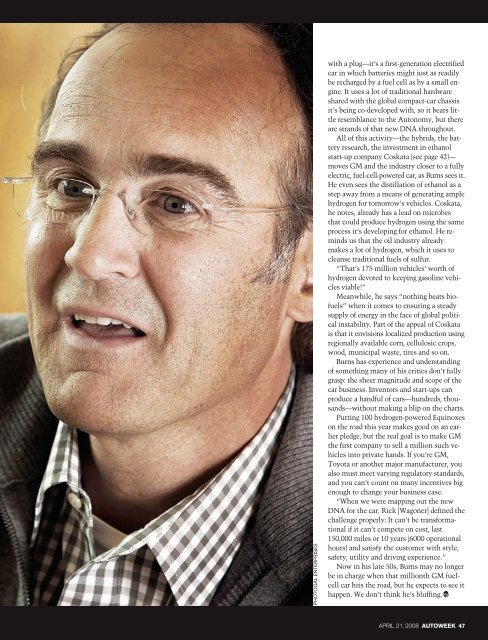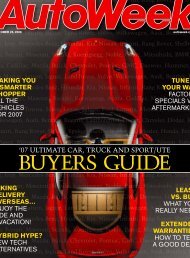SPECIAL EARTH DAY DOUBLE ISSUE - AutoWeek
SPECIAL EARTH DAY DOUBLE ISSUE - AutoWeek
SPECIAL EARTH DAY DOUBLE ISSUE - AutoWeek
You also want an ePaper? Increase the reach of your titles
YUMPU automatically turns print PDFs into web optimized ePapers that Google loves.
PHOTOGAL ENTERPRISES<br />
with a plug—it’s a first-generation electrified<br />
car in which batteries might just as readily<br />
be recharged by a fuel cell as by a small engine.<br />
It uses a lot of traditional hardware<br />
shared with the global compact-car chassis<br />
it’s being co-developed with, so it bears little<br />
resemblance to the Autonomy, but there<br />
are strands of that new DNA throughout.<br />
All of this activity—the hybrids, the battery<br />
research, the investment in ethanol<br />
start-up company Coskata (see page 42)—<br />
moves GM and the industry closer to a fully<br />
electric, fuel-cell-powered car, as Burns sees it.<br />
He even sees the distillation of ethanol as a<br />
step away from a means of generating ample<br />
hydrogen for tomorrow’s vehicles. Coskata,<br />
he notes, already has a lead on microbes<br />
that could produce hydrogen using the same<br />
process it’s developing for ethanol. He reminds<br />
us that the oil industry already<br />
makes a lot of hydrogen, which it uses to<br />
cleanse traditional fuels of sulfur.<br />
“That’s 175 million vehicles’ worth of<br />
hydrogen devoted to keeping gasoline vehicles<br />
viable!”<br />
Meanwhile, he says “nothing beats biofuels”<br />
when it comes to ensuring a steady<br />
supply of energy in the face of global political<br />
instability. Part of the appeal of Coskata<br />
is that it envisions localized production using<br />
regionally available corn, cellulosic crops,<br />
wood, municipal waste, tires and so on.<br />
Burns has experience and understanding<br />
of something many of his critics don’t fully<br />
grasp: the sheer magnitude and scope of the<br />
car business. Inventors and start-ups can<br />
produce a handful of cars—hundreds, thousands—without<br />
making a blip on the charts.<br />
Putting 100 hydrogen-powered Equinoxes<br />
on the road this year makes good on an earlier<br />
pledge, but the real goal is to make GM<br />
the first company to sell a million such vehicles<br />
into private hands. If you’re GM,<br />
Toyota or another major manufacturer, you<br />
also must meet varying regulatory standards,<br />
and you can’t count on many incentives big<br />
enough to change your business case.<br />
“When we were mapping out the new<br />
DNA for the car, Rick [Wagoner] defined the<br />
challenge properly: It can’t be transformational<br />
if it can’t compete on cost, last<br />
150,000 miles or 10 years (6000 operational<br />
hours) and satisfy the customer with style,<br />
safety, utility and driving experience.”<br />
Now in his late 50s, Burns may no longer<br />
be in charge when that millionth GM fuelcell<br />
car hits the road, but he expects to see it<br />
happen. We don’t think he’s bluffing. c<br />
APRIL 21, 2008 AUTOWEEK 47



